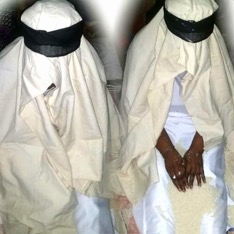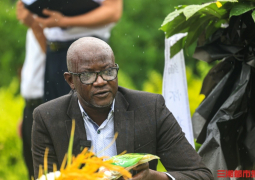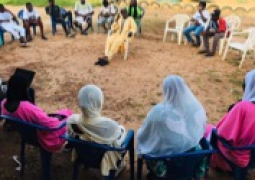
The enduring beauty of what they built from near-imperfect credence now survives on the tongues and hands of the ornaments of blood and bone they have yielded. In awe, we sway with the traditions that were birthed by their wisdom to arm and educate she who is about to become a home and a vessel of life.
Marriage is monumental and exciting but remains to be a generous catalyst, and with a better half of its pressure socially wedged into women, it is of colossal relevance that they are offered gears that will ground them and pave them a way they can use to better navigate their new life. With courtship and wedding ceremonies all about enjoyment, ‘Murr’ offers a more grounding reality as words and tradition deliver the bride into the bittersweet hands of married life.
On the night of the wedding, after the celebration dies down with its warmth still lingering about the air, the bride is escorted to her mother’s home where the Murr is set to take place. In all of her natural glory, she is accompanied to the bathroom where she is made to sit on a mortar and given a ritual bath (ghusl) by her mother and her aunt (Bajen) with its purpose essentially to purify her being. Once the ritual bath concludes, the bride kicks the mortar to the ground and from there on forth is not allowed to look back or talk as she is placed on the mat (Basang) lying in the middle of the room. With the traditional presence of seven people in the room; three aunts (Bajens) from the father’s side of the family, three from the mother’s side of the family, and a relative from either side to sum up seven people, the Murr begins a meaningful sail.
As per tradition, the three paternal aunts take turns and commence covering her being with pieces of white cloth (Perkaal), they start from her feet to the top of her head, murmuring a string of advices as they go along. The maternal aunts and the remaining relative iterate the process with meticulous hands, leaving the mother of the bride to do the final covering who then ties a black piece of cloth around the white veil to keep it in place. This black cloth placed on the bride’s head (‘Njorr’) represents the hardships she will encounter in her marriage.
Now sacredly clothed and bare of any accessories, the bride’s mother advises her on how to be a good wife, “Sor demeh gorgorlu sey teh yala tah”, tearfully prays for her and spits over her head. The bride then rises with the grace of a newly spirited soul and walks to any Soto tree in the vicinity, accompanied by a large crowd. There she circles the tree three times, and on the final round, bends over and bites (Ngange) on the bark of the tree. The bark that is gathered from this bite is then tied into a cloth and kept away for later use. She is trailed to her husband’s house following this, forbidden to talk and look back because it is considered a bad omen and if not heeded the bride may encounter infertility and other misfortunes.
A warm welcome is received at the groom’s home and the bride is sat on a mat on the verandah, her entourage mixed in with the groom’s crowd creating a festive. She then has cotton pads housing salt traditionally called ‘Darr’ slotted between her fingers, a silver bangle placed in the middle of her palms combined, and a basin (Leket) placed on the mat beside her. One of the ‘Njekehs’ (a cousin or a very good friend of the groom) grabs the initiative to pour millet (Dugub) into the palms of the bride and guides her to pour it into the basin, this is done three times and iterated with the back of her hands. This millet is later poured over the head of the bride and gathered back into the basin. A friend of the groom then walks in, stands beside the bride, and stuffs a handful of the millet in his mouth. He makes rabid noises (Ngahal) with it before spitting it back into the basin. This is repeated three times after which he will dance around the bride until he is content enough to leave.
The ‘Njekehs’ of the bride then take over, dancing around her and singing “Bisimillah am neng jabarr teh du nyu abi jabarr, bisimillah am neng jabarr.” When they cease singing the Raame starts; this is when the bride crawls to her husband’s room, during which she is accompanied by three elders (all first wives) who have never left their marital homes (Faye) because of separation or anger. Along with them comes a friend of the groom, and a cousin of the bride who will carry the Incense burner (Anda). She crawls (Raams) to her husband’s room where a mattress (Mbeufeun) is placed on the floor, four calotropis procera (Poftan) leaves placed under each corner and one in the middle. This is done to warn the evil eye away from the newlyweds. The bride crawls around the room three times before she gets on the mattress to join her husband as a sign of submission.
The bride shakes the groom’s hand who then pulls her into his chest and offers her a kiss. This is then followed by the sharing of the porridge (Xechoo Laah).They will bring in a basin (Leket) of porridge (Laah) and sour milk (sow) prepared by one of the bride’s aunts. The groom will scoop the ‘Laah’ into a spoon (Qoork), puts it in his mouth, and spit its back into the spoon. he feeds this to his wife who then swallows it. The newlyweds then proceed to eat together and once they are done their leftovers are consumed by the people present in the room. This is to ensure harmony within the matrimonial home.
Following the Xechoo Laah, the three elders advise the bride on patience, endurance, and ‘Sutura’, and the groom is advised on how to be an encompassing partner. The incense burner is placed in the corner of the room and the newlyweds are then left to consummate the marriage. One of the Bajens stays by the door throughout the night in case the bride needs moral support on her first night with her husband.
The next morning after the consummation the bride is taken around the house to formally greet her in-laws and her husband’s relatives as well as familiarize herself with the home. The millet (Dugub) and the bark of the tree from the ‘Soto’ are then ground (Soha) and turned into Cherreh. This is what the bride uses to cook her first dinner in her husband’s home. It can either be ‘Cherreh ak nyehi yapa’ or ‘Cherreh ak nyehi jen’. She isn’t required to cook this right after her first night. This act can be fulfilled from two days to a week into her matrimonial home.
This food is shared by everyone in the house as a sign of unity and to mark the official welcome of the bride as part of the family. Women, married and unmarried, who haven’t experienced Murr are never allowed to be part of the intimate moments of it because of how sacred it is.
The traditional practices of Murr radiate a religious beauty that is almost too sacred to still be in existence. But it thrives and thrums in the veins of its believers, embedded in the souls of those who experienced it, and leaves an air of wondrous curiosity in those who haven’t. It sings values that cannot be taught through words and serves as a guiding light to people who carry generations.
Mam Nabout Kah is a final year student at the School of Journalism and Digital Media, University of The Gambia (UTG). She is currently working with The Point as an intern.
Read Other Articles In Feature

China-Africa Cooperation: Cultivating hope and future in Gambia's rice fields
Jun 16, 2025, 12:57 PM




